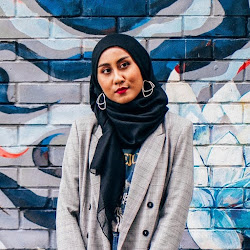
Shah and I went to perform the umrah recently but before doing so in Mecca, we made our way to the city of Medina, situated about five hours away.
A lot of my blog readers are Muslims (according to analytics, that is) who already know plenty about what people do on an umrah trip, but I also have a lot of readers who are of different faiths and religions so I'll try to explain my umrah story as best as I can!
Umrah is one of the two pilgrimages undertaken by Muslims that are entirely performed in Mecca — the other being the hajj — but it is common for Muslims to include Medina in their itinerary, solely with the goal to visit Al-Masjid an-Nabawi or simply Masjid Nabawi, also known as the Prophet's Mosque ("masjid" is Arabic for mosque). It was built by our Prophet Muhammad p.b.u.h. (peace be upon him) and it also serves as his final resting place, with his tomb under the prominent green dome.
Aside from performing the five main prayers a day, we visit the mosque with the intention to perform other forms of ibadat as well; "ibadat" is an Arabic word that very roughly translates to "good deeds", and the word covers the acts of worshipping in the name of Allah, our God, which include reading the Quran and reciting tasbih and zikir (two words that describe saying short phrases of prayers of praising our God). Even visiting the tomb of the Prophet to recite prayers for him is considered an act of ibadat.
The important thing to know is we do all these ibadat to make us better connect to Allah spiritually, and hence, become better Muslims.
• • • • • • •
A simple background story: Medina's mark in the history of Islam is as the city our Prophet Muhammad p.b.u.h. hijrah or migrated to from Mecca when his life was in peril, as men of the Quraysh threatened to kill him — basically out of fear of the Prophet's influence in spreading Islam. After the hijrah, Islam prospered in Medina and was strengthened in numbers, which led to the chain of events that eventually enabled Muslims to return back to Mecca.
An important historical mark of the hijrah is the start of the Islamic calendar. In case you didn't know it, yes, Islam has its own calendar, which is based on the phases of the moon. We are currently in the 9th month of the calendar a.k.a. Ramadhan, the holy month when Muslims are required to fast from dawn till dusk.
• • • • • • •
Here's the thing about Masjid Nabawi: it is GORGEOUS. My photos here honestly do not do the mosque any justice whatsoever. Masjid Nabawi is well-known for the giant mechanical umbrellas in its courtyard which open up during the day to protect worshippers from the heat of the sun and from the rain. They don't only serve a practical purpose but are also truly the highlight of the mosque's aesthetic.
I hope you enjoy my little photo diary on Madinah! All photos were taken using iPhone 7s + and iPhone XS. If you have any questions about my trip to Madinah, don't hesitate to ask!
 |
| The beautiful giant umbrellas surrounding the mosque's facade |
 |
| One of Masjid Nabawi's large golden doors behind Shah, who was wearing his black tunic robe which we call jubah in Malaysian Language (also called "thawb" or "thobe" in Arabic) |

 |
| The green dome above the Prophet's final resting place |
 |
| I loved the Starbucks here! |
 |
| Visiting Masjid Quba', the mosque in the hadith that says a prayer done in it will have the same reward as having perform an umrah |
 |
| Of course I had to indulge in one of my favourite hobbies! I'm a huge fan of black abayas and had the hardest time choosing my favourites |
 |
| Us in the mosque's piazza area. I was holding Zamzam water, the slightly alkaline water which can only be sourced from its well in Mecca, but available from the many water taps around Masjid Nawabi |
 |
| Me (yes it me!) in a niqab |
I had never ever worn nor purchased a niqab — the veil that some Muslim women use to cover their face except for the eye area — so I was curious (and even excited) about trying it out while I was on my umrah trip. I might explore that experience in a future post, so keep an eye out for that, guys! Thanks for reading this post ❤





















You did a wonderful job of explaining many aspects of Ramadan of which I was unaware. The Muslim faith is rich in ritual and very public declarations of faith and adherence to tradition.
ReplyDeleteThe Mosque is amazing, so ornate and grand. Those umbrellas are lovely and functional!! Love. Jude
I am so, so glad you enjoy reading this post, my dear Judy <3 It's a pleasure for me to share my Umrah and Ramadhan stories with you.
DeleteAmeen. Thank you.
ReplyDeleteamazing photo
ReplyDelete